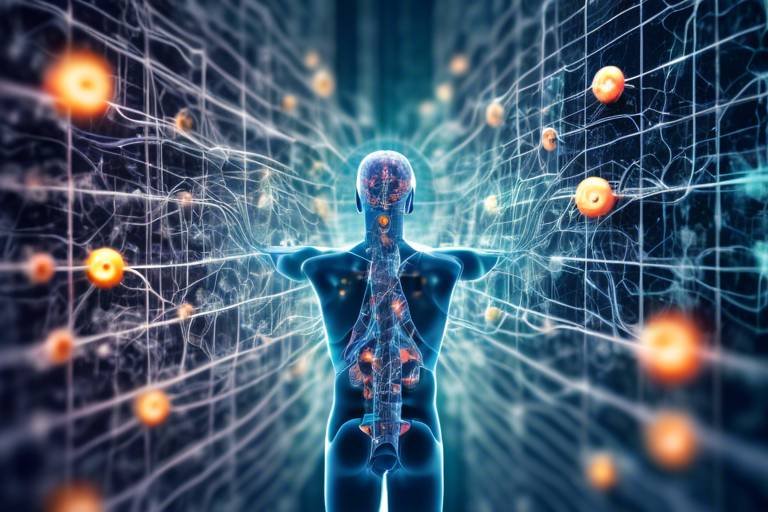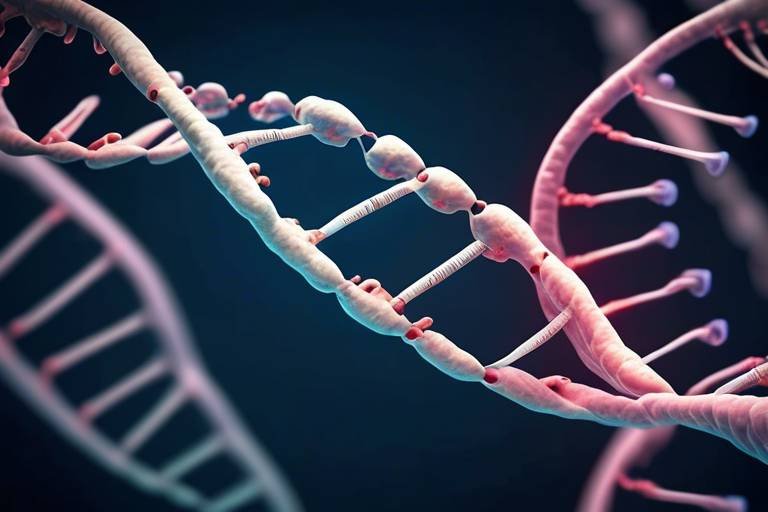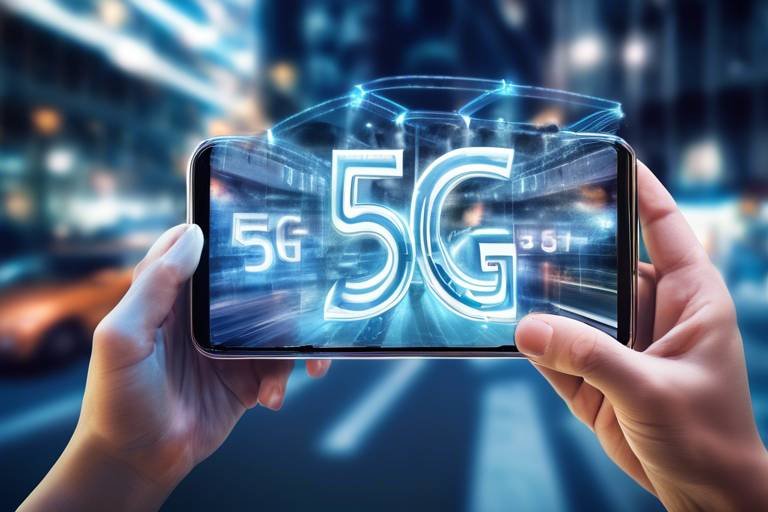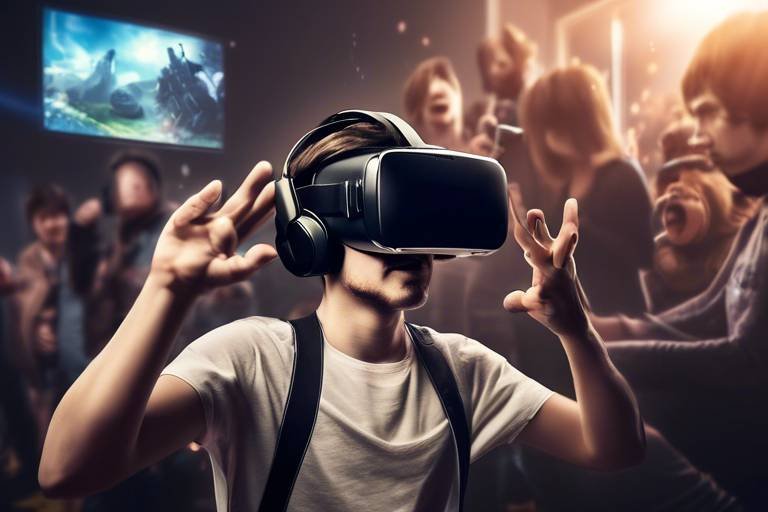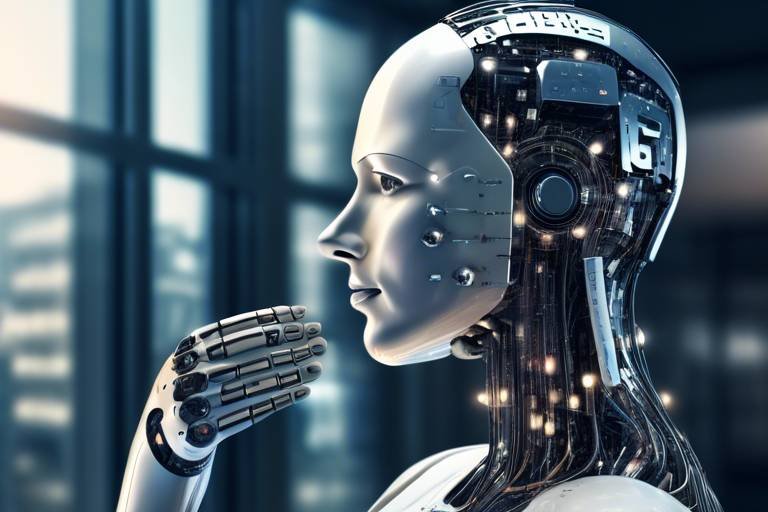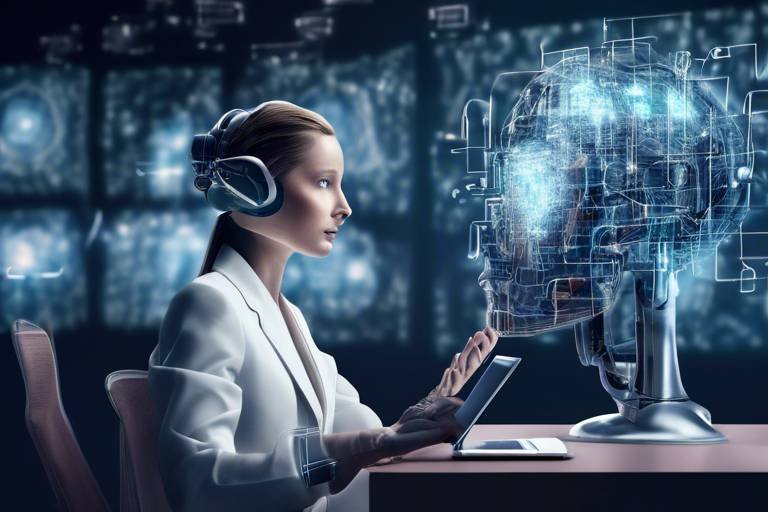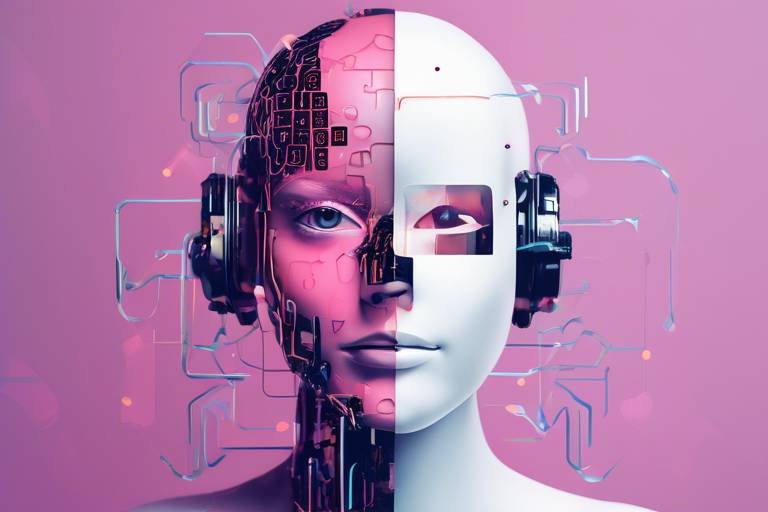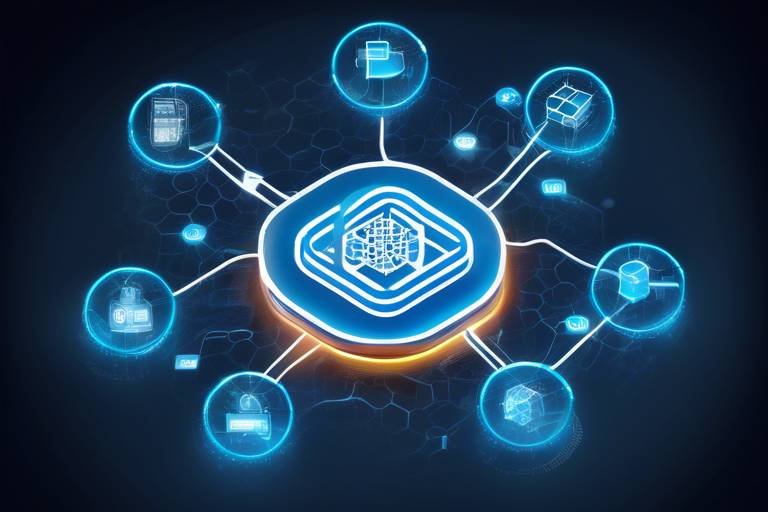Deep Learning: Revolutionizing Healthcare Analytics
In today's fast-paced world, the healthcare industry is witnessing a seismic shift, largely driven by the power of deep learning. This innovative technology is not just a buzzword; it is reshaping the landscape of healthcare analytics in ways that were once unimaginable. Imagine a scenario where diseases are diagnosed with pinpoint accuracy, treatment plans are tailored to individual patients, and healthcare operations run like a well-oiled machine. Sounds like science fiction? Well, it’s becoming a reality thanks to deep learning.
Deep learning, a subset of artificial intelligence (AI), utilizes complex algorithms and neural networks to analyze vast amounts of data. By mimicking the way the human brain processes information, these systems can uncover patterns and insights that traditional methods might miss. This is particularly crucial in healthcare, where the stakes are high, and timely, accurate information can mean the difference between life and death.
As we delve deeper into this article, we’ll explore the various facets of how deep learning is transforming healthcare analytics. From improving diagnostic accuracy to enhancing patient care and streamlining operations, the implications are profound. Furthermore, we will address the challenges that come with implementing such advanced technologies and look ahead to future trends that promise to further revolutionize the field.
So, buckle up as we embark on this exciting journey through the world of deep learning in healthcare analytics. The future is bright, and it's powered by data!
Understanding the fundamental concepts of deep learning, including neural networks and algorithms, is essential for appreciating its applications in healthcare analytics. At its core, deep learning involves layers of algorithms that process data in a hierarchical manner. Each layer extracts different features, gradually building a comprehensive understanding of the input data. This is akin to peeling an onion, where each layer reveals more about the core.
Neural networks, the backbone of deep learning, are designed to simulate the way neurons in the human brain communicate. They consist of interconnected nodes, or "neurons," that work together to analyze data. The more data these networks process, the better they become at recognizing patterns and making predictions. This is particularly beneficial in healthcare, where the ability to analyze complex data sets can lead to groundbreaking advancements in patient care.
Deep learning models are increasingly used to improve diagnostic accuracy, enabling earlier detection of diseases through advanced image analysis and predictive analytics. For instance, in radiology, deep learning algorithms can analyze medical images—such as X-rays, MRIs, and CT scans—far more efficiently than a human radiologist. Studies have shown that these models can achieve diagnostic accuracy levels that rival or even surpass human experts.
Imagine a world where a patient’s cancer can be detected in its earliest stages, significantly improving treatment outcomes. Deep learning makes this possible by identifying subtle patterns in imaging data that might go unnoticed by the human eye. The result? Earlier interventions, more effective treatments, and ultimately, lives saved.
By analyzing patient data, deep learning can personalize treatment plans, predict patient outcomes, and improve overall care quality, leading to better health management. This technology allows healthcare providers to tailor interventions based on individual patient profiles, considering factors such as genetics, lifestyle, and previous health history.
For example, deep learning can analyze data from wearable devices that monitor heart rates, activity levels, and other vital signs. This information can be used to predict potential health issues before they become critical, enabling proactive care. It’s like having a personal health assistant that’s always on the lookout for your well-being!
Deep learning technologies help optimize hospital operations, including patient flow management, resource allocation, and scheduling, which ultimately enhances efficiency and reduces costs. By analyzing historical data, these systems can predict patient admission rates, allowing hospitals to allocate resources more effectively.
Consider this: when a hospital can accurately forecast patient volumes, it can ensure that staff and supplies are available when needed, reducing wait times and improving patient satisfaction. This not only enhances the patient experience but also leads to significant cost savings for healthcare providers.
Leveraging deep learning in drug discovery accelerates the identification of potential drug candidates, optimizing the research and development process in the pharmaceutical industry. Traditional drug discovery methods can take years and cost billions of dollars. However, deep learning can analyze vast chemical libraries and predict which compounds are likely to be effective, significantly shortening the time frame.
This is a game-changer for the industry. With deep learning, researchers can focus their efforts on the most promising candidates, reducing waste and increasing the likelihood of successful outcomes. It’s like having a crystal ball that reveals the best paths to take in the complex world of drug development.
Deep learning facilitates predictive analytics in public health, allowing for better forecasting of disease outbreaks and effective allocation of resources during health crises. By analyzing data from various sources, including social media, healthcare records, and environmental factors, deep learning models can predict potential outbreaks before they occur.
This capability is invaluable for public health officials, enabling them to implement preventive measures and allocate resources where they are needed most. It’s as if deep learning acts as an early warning system, helping to safeguard communities and improve overall public health outcomes.
Despite its potential, implementing deep learning in healthcare faces challenges, including data privacy concerns, integration with existing systems, and the need for skilled professionals. As healthcare organizations strive to adopt these technologies, they must navigate a complex landscape of regulations and ethical considerations.
Moreover, the integration of deep learning systems into existing workflows can be daunting. Organizations need to ensure that their staff is adequately trained and that the technology aligns with their operational needs. It’s a balancing act that requires careful planning and execution.
The future of deep learning in healthcare analytics promises advancements in AI technologies, increased automation, and a greater focus on ethical considerations in patient data use. As these technologies continue to evolve, we can expect even more innovative applications that enhance patient care and streamline operations.
Moreover, with the growing emphasis on data privacy and security, future developments will likely prioritize ethical AI practices, ensuring that patient data is handled responsibly. This is not just about technology; it’s about building trust with patients and healthcare providers alike.
As deep learning continues to evolve, its impact on healthcare analytics will be profound, driving innovations that enhance patient outcomes and revolutionize the healthcare landscape. We are on the brink of a new era in healthcare, one where data-driven decisions lead to better health management and improved quality of care.
- What is deep learning? Deep learning is a subset of artificial intelligence that uses neural networks to analyze and interpret complex data.
- How does deep learning improve disease diagnosis? Deep learning algorithms can analyze medical images and data to identify patterns that lead to earlier and more accurate diagnoses.
- What challenges does deep learning face in healthcare? Key challenges include data privacy concerns, integration with existing systems, and the need for skilled professionals.
- What are the future trends in healthcare analytics? Future trends include advancements in AI technologies, increased automation, and a focus on ethical considerations in patient data use.

The Basics of Deep Learning
Deep learning is a subset of artificial intelligence (AI) that mimics the workings of the human brain to process data and create patterns for use in decision-making. At its core, deep learning relies on neural networks, which are computational models inspired by the biological neural networks that constitute animal brains. These networks consist of layers of interconnected nodes, or "neurons," that work together to analyze and interpret complex data.
To understand deep learning, it’s essential to grasp the concept of neural networks. A neural network is typically organized into three types of layers: the input layer, hidden layers, and the output layer. Each layer consists of multiple neurons that process inputs and pass them to the next layer. The magic happens in the hidden layers, where the network learns to extract features and patterns from the data through a process called backpropagation. This involves adjusting the weights of connections based on the errors made in predictions, allowing the model to improve over time.
Deep learning excels in handling vast amounts of data, making it particularly valuable in fields like healthcare analytics. Here’s a quick breakdown of how it works:
- Data Input: Raw data, such as medical images or patient records, is fed into the neural network.
- Feature Extraction: The network automatically identifies relevant features from the data without needing manual intervention.
- Prediction: The processed information is used to make predictions or classifications, such as diagnosing a disease based on imaging data.
One of the most exciting aspects of deep learning is its ability to improve with experience. Just like a child learns from exposure to various stimuli, deep learning models become more accurate as they are trained on larger datasets. This capability is particularly crucial in healthcare, where the volume of data generated is immense. From electronic health records to genomic sequences, deep learning can sift through this information to uncover insights that would be impossible for humans to detect.
However, while deep learning holds great promise, it also comes with its own set of challenges. The complexity of these models can make them difficult to interpret, often referred to as the "black box" problem. This lack of transparency can be a significant hurdle in healthcare, where understanding the reasoning behind a diagnosis or treatment recommendation is critical. Moreover, the reliance on large datasets raises concerns about data privacy and the ethical use of patient information.
In summary, the basics of deep learning involve understanding how neural networks function and their potential applications in various fields, particularly healthcare. As we delve deeper into the transformative effects of deep learning on healthcare analytics, it becomes clear that this technology is not just a passing trend but a fundamental shift in how we approach medical data and decision-making.

Applications in Disease Diagnosis
Deep learning is making waves in the field of disease diagnosis, and it's not just a ripple—it's a tidal wave of transformation! Imagine being able to detect diseases at a stage so early that treatment becomes significantly more effective. This is the reality that deep learning brings to healthcare analytics. By utilizing advanced algorithms and neural networks, deep learning can analyze vast amounts of medical data, including images, lab results, and patient histories, to provide insights that were previously unimaginable.
One of the most significant applications of deep learning in disease diagnosis is in the realm of medical imaging. For instance, deep learning models can be trained to recognize patterns in X-rays, MRIs, and CT scans. These models can identify anomalies that may indicate conditions such as tumors, fractures, or other diseases with a level of precision that rivals, and in some cases surpasses, human radiologists. This not only enhances the accuracy of diagnoses but also speeds up the entire process, allowing for quicker interventions that can save lives.
Moreover, deep learning is not limited to just imaging. It extends to predictive analytics, where algorithms can sift through historical patient data to identify risk factors for various diseases. For example, by analyzing data such as age, family history, lifestyle choices, and previous health conditions, deep learning can predict the likelihood of developing conditions like diabetes or heart disease. This proactive approach empowers healthcare providers to implement preventive measures, ultimately leading to better patient outcomes.
To illustrate the power of deep learning in disease diagnosis, consider the following table that highlights some key applications:
| Application | Description | Benefits |
|---|---|---|
| Medical Imaging | Analyzing X-rays, MRIs, and CT scans to detect diseases. | Increased accuracy and speed of diagnosis. |
| Predictive Analytics | Using historical data to predict disease risk. | Proactive healthcare measures and prevention. |
| Genomic Analysis | Interpreting genetic data to identify predispositions to diseases. | Personalized medicine and targeted treatments. |
In addition to these applications, deep learning is also enhancing the accuracy of pathology reports. By analyzing tissue samples, deep learning algorithms can assist pathologists in identifying cancerous cells with remarkable precision. This synergy between human expertise and machine learning not only improves diagnostic accuracy but also reduces the workload on healthcare professionals, allowing them to focus on patient care rather than getting bogged down in data analysis.
As we look to the future, the potential of deep learning in disease diagnosis seems limitless. With ongoing advancements in technology and data collection methods, we can expect even more innovative applications that will further enhance diagnostic capabilities. The integration of deep learning into clinical workflows is not just a trend; it represents a fundamental shift in how we approach healthcare diagnostics, paving the way for a healthier future.
- What is deep learning? Deep learning is a subset of artificial intelligence that uses neural networks to analyze large amounts of data and identify patterns.
- How does deep learning improve disease diagnosis? By analyzing medical images and patient data, deep learning can enhance the accuracy and speed of diagnoses, leading to better patient outcomes.
- Are there any risks associated with using deep learning in healthcare? Yes, challenges include data privacy concerns, the need for skilled professionals, and the integration of deep learning systems with existing healthcare infrastructures.
- What is the future of deep learning in healthcare? The future promises advancements in AI technologies, increased automation, and a greater focus on ethical considerations in patient data use.

Enhancing Patient Care
In the fast-evolving world of healthcare, deep learning is emerging as a game-changer, particularly when it comes to enhancing patient care. Imagine a scenario where your doctor not only understands your medical history but also leverages advanced algorithms to tailor your treatment plan specifically to your needs. This isn't science fiction; it's the reality that deep learning is bringing to the table. By analyzing vast amounts of patient data, these intelligent systems can identify patterns and trends that human practitioners might overlook.
One of the most significant ways deep learning enhances patient care is through personalized treatment plans. Traditional medicine often adopts a one-size-fits-all approach, which can lead to suboptimal outcomes for many patients. However, with the aid of deep learning, healthcare providers can analyze individual patient data—such as genetic information, lifestyle choices, and previous treatment responses—to create highly customized treatment strategies. This not only increases the likelihood of successful outcomes but also helps in minimizing side effects, as treatments can be tailored to suit the unique biological makeup of each patient.
Furthermore, deep learning models are making strides in predicting patient outcomes. By utilizing historical data and advanced predictive analytics, these models can forecast potential health issues before they arise. For instance, a deep learning system might analyze a patient’s records and identify that they are at a higher risk for developing diabetes based on specific markers. Armed with this information, healthcare providers can intervene early, implementing preventative measures that can significantly improve the patient's quality of life.
Another fascinating aspect of deep learning in patient care is its ability to enhance the overall quality of care. With the integration of these technologies, healthcare professionals can spend less time on administrative tasks and more time focusing on patient interaction. Deep learning algorithms can automate routine processes such as data entry and appointment scheduling, allowing practitioners to devote their energy to what truly matters: their patients. This shift not only improves patient satisfaction but also fosters a more compassionate healthcare environment.
Moreover, the insights gained through deep learning can lead to better health management across various demographics. For instance, consider the elderly population, who often face multiple health challenges. Deep learning can analyze data from wearable devices, providing real-time insights into their health status and alerting caregivers or medical professionals to any concerning changes. This proactive approach ensures that patients receive timely interventions, ultimately leading to improved health outcomes.
In summary, the integration of deep learning into patient care is not merely a technological upgrade; it represents a fundamental shift in how healthcare is delivered. By personalizing treatment plans, predicting outcomes, and streamlining operations, deep learning is enhancing the quality of care that patients receive. As we move forward, it will be exciting to see how these advancements continue to shape the future of healthcare, making it more efficient, effective, and patient-centered.
- What is deep learning?
Deep learning is a subset of artificial intelligence that uses neural networks to analyze vast amounts of data, enabling machines to learn and make decisions. - How does deep learning improve patient care?
Deep learning enhances patient care by personalizing treatment plans, predicting health outcomes, and streamlining healthcare operations. - Are there any challenges in implementing deep learning in healthcare?
Yes, challenges include data privacy concerns, integration with existing systems, and the need for skilled professionals to manage these technologies.

Streamlining Healthcare Operations
In the fast-paced world of healthcare, efficiency isn't just a buzzword—it's a necessity. With the increasing demand for quality patient care and the constant pressure to reduce costs, healthcare organizations are turning to deep learning to streamline their operations. Imagine a system where hospitals can predict patient inflow with remarkable accuracy, manage resources effectively, and schedule staff in a way that maximizes productivity. This is not just a dream; it's the reality that deep learning is making possible.
At the core of this transformation is the ability of deep learning algorithms to analyze vast amounts of data quickly and accurately. For instance, by examining historical patient data, these algorithms can forecast patient admissions and discharges. This predictive capability allows hospitals to optimize their staffing levels, ensuring that they have the right number of healthcare professionals available when they are needed the most. As a result, hospitals can avoid the chaos of overcrowded emergency rooms and long wait times, leading to a smoother experience for both patients and staff.
Moreover, deep learning can enhance resource allocation by identifying patterns in how resources are used. For example, a hospital might analyze data on equipment usage, medication distribution, and even the flow of patients through various departments. By understanding these patterns, healthcare administrators can make informed decisions about where to invest in new technologies or how to better utilize existing resources. This not only reduces waste but also ensures that patients receive timely and effective care.
Another significant area where deep learning is making waves is in scheduling. Traditional scheduling methods often lead to inefficiencies, with staff either overworked or underutilized. Deep learning algorithms can analyze various factors—such as patient volume, staff availability, and even seasonal trends—to create optimized schedules that meet the needs of both patients and healthcare providers. This leads to a more balanced workload and improved job satisfaction among staff, which is crucial in an industry where burnout is a real concern.
To illustrate the impact of deep learning on healthcare operations, consider the following table that summarizes key benefits:
| Benefit | Description |
|---|---|
| Predictive Analytics | Forecasting patient admissions and discharges to optimize staffing levels. |
| Resource Optimization | Analyzing usage patterns to improve resource allocation and reduce waste. |
| Enhanced Scheduling | Creating optimized staff schedules based on patient volume and staff availability. |
In addition to these operational benefits, deep learning also fosters a culture of continuous improvement within healthcare organizations. By regularly analyzing operational data, hospitals can identify areas for improvement and implement changes that lead to better patient outcomes. This iterative process not only enhances efficiency but also contributes to a more responsive and adaptive healthcare system.
However, while the advantages of deep learning in streamlining healthcare operations are clear, it's important to acknowledge the challenges that come with its implementation. Issues such as data integration, the need for skilled personnel, and concerns about data privacy must be addressed to fully harness the potential of this technology. Nevertheless, as more healthcare organizations embrace deep learning, the landscape of healthcare operations is poised for a significant transformation.
- What is deep learning? Deep learning is a subset of artificial intelligence that involves neural networks to analyze large amounts of data and make predictions or decisions.
- How does deep learning improve healthcare operations? By providing predictive analytics, optimizing resource allocation, and enhancing scheduling, deep learning helps healthcare organizations operate more efficiently.
- What are some challenges of implementing deep learning in healthcare? Challenges include data privacy concerns, integration with existing systems, and the need for trained professionals to manage the technology.

Drug Discovery and Development
In the realm of healthcare, the journey from discovering a potential drug to bringing it to market is often a long and winding road, fraught with challenges and uncertainties. However, deep learning is changing the game in drug discovery and development, making this process not only faster but also more efficient. Imagine having a powerful assistant that can sift through vast amounts of data, identify patterns, and predict outcomes—this is precisely what deep learning does for researchers in the pharmaceutical industry.
At its core, deep learning utilizes neural networks to analyze complex datasets. These networks are designed to mimic the way the human brain works, allowing them to learn from data and improve over time. In drug discovery, this capability is invaluable. Traditionally, researchers would spend years testing various compounds in laboratories, often with little success. Now, with deep learning algorithms, they can analyze existing databases of chemical compounds and biological data to identify promising candidates much more quickly.
For instance, deep learning can help in predicting how different molecules will interact with specific biological targets. By using historical data and advanced predictive models, researchers can prioritize which compounds to test, significantly reducing the time and cost associated with drug development. This is akin to having a crystal ball that forecasts which paths are most likely to lead to success, allowing scientists to focus their efforts where they are most likely to yield results.
Moreover, deep learning can also assist in personalizing medicine. By analyzing patient data, including genetic information, researchers can tailor drug therapies to individual needs, enhancing efficacy and minimizing side effects. This approach not only improves patient outcomes but also streamlines the overall development process, as drugs can be designed specifically for targeted populations.
To illustrate the impact of deep learning on drug discovery, consider the following table that summarizes key advantages:
| Advantage | Description |
|---|---|
| Speed | Accelerates the identification of viable drug candidates. |
| Cost-Effectiveness | Reduces the financial burden associated with lengthy drug development processes. |
| Precision | Enables the design of personalized therapies based on patient-specific data. |
| Data Utilization | Maximizes the use of existing data to inform new discoveries. |
Despite these advancements, the integration of deep learning into drug discovery is not without its challenges. Issues such as data quality, the need for vast datasets, and the potential for bias in the algorithms must be addressed. Additionally, regulatory bodies are still catching up with these new technologies, creating a landscape where innovation must navigate complex approval processes.
In conclusion, deep learning is revolutionizing drug discovery and development by making it faster, more efficient, and more tailored to individual patient needs. As this technology continues to evolve, we can expect to see even more breakthroughs that could lead to the next generation of life-saving therapies.
- What is deep learning? Deep learning is a subset of machine learning that uses neural networks to analyze data and make predictions.
- How does deep learning improve drug discovery? It accelerates the identification of potential drug candidates by analyzing vast datasets and predicting outcomes more accurately.
- Are there challenges in using deep learning for drug development? Yes, challenges include data quality, algorithm bias, and regulatory hurdles.
- Can deep learning personalize medicine? Absolutely! Deep learning can analyze patient data to tailor drug therapies to individual needs.

Predictive Analytics for Public Health
In the realm of public health, predictive analytics powered by deep learning is like having a crystal ball that helps us foresee potential health crises before they spiral out of control. Imagine being able to predict an outbreak of a disease weeks or even months in advance; this is not just a dream but a reality made possible by the sophisticated algorithms that analyze vast amounts of data. By leveraging historical data, demographic information, and even social media trends, these models can identify patterns that human analysts might miss.
One of the most significant advantages of predictive analytics is its ability to enhance decision-making processes. For instance, health organizations can allocate resources more effectively, ensuring that vaccines and medical supplies reach areas that are predicted to be at high risk. This proactive approach not only saves lives but also minimizes the economic burden on healthcare systems. In a world where every second counts, being able to anticipate needs can make all the difference.
Moreover, deep learning algorithms can analyze complex datasets that include environmental factors, population mobility, and even climate data. This comprehensive approach allows for a more nuanced understanding of how diseases spread. For example, during a flu season, predictive models can assess how weather changes might influence the transmission rates, enabling public health officials to implement timely interventions.
Here’s a quick look at how predictive analytics can impact public health:
- Outbreak Prediction: Identifying potential outbreaks before they occur.
- Resource Allocation: Optimizing the distribution of medical supplies and personnel.
- Health Trend Analysis: Understanding long-term health trends to inform policy decisions.
However, the implementation of predictive analytics is not without its challenges. Data privacy is a significant concern, as sensitive information must be handled with care to protect patient confidentiality. Additionally, there is a need for robust data infrastructure to ensure that the data being analyzed is accurate and up-to-date. Without reliable data, even the most advanced algorithms can lead to misguided conclusions.
As we look to the future, the integration of predictive analytics in public health will likely expand, driven by advancements in technology and a greater emphasis on data-driven decision-making. By harnessing the power of deep learning, we can not only improve our response to health crises but also foster a healthier society overall. The potential for innovation in this field is vast, and as we continue to refine these tools, the possibilities become even more exciting.
- What is predictive analytics in public health? Predictive analytics in public health involves using data and statistical algorithms to identify the likelihood of future health outcomes based on historical data.
- How does deep learning enhance predictive analytics? Deep learning enhances predictive analytics by enabling the analysis of large and complex datasets, improving the accuracy of predictions.
- What are the challenges of implementing predictive analytics? Key challenges include data privacy concerns, the need for high-quality data, and integration with existing health information systems.

Challenges in Implementation
While the potential of deep learning in healthcare analytics is nothing short of revolutionary, it's important to acknowledge the challenges that come with its implementation. One of the most pressing issues is data privacy. With sensitive patient information at stake, healthcare organizations must navigate strict regulations such as HIPAA in the United States. Ensuring that patient data is securely handled and that privacy is maintained can be a daunting task, especially when integrating deep learning systems that require vast amounts of data to function effectively.
Another significant hurdle is the integration with existing systems. Many healthcare facilities rely on legacy systems that may not be compatible with modern deep learning technologies. This can lead to a fragmented approach where data silos exist, making it difficult to achieve a holistic view of patient care. The transition to a more integrated system often requires substantial investment in both time and resources, which can deter organizations from pursuing these advanced technologies.
Moreover, there is a shortage of skilled professionals who understand both healthcare and deep learning. Bridging the gap between these two fields is crucial for successful implementation. Healthcare organizations often struggle to find data scientists who can translate complex algorithms into actionable insights for medical professionals. This skill gap can slow down the adoption of deep learning technologies and limit their effectiveness in improving patient outcomes.
Additionally, the interpretability of deep learning models poses a challenge. Unlike traditional statistical methods, deep learning algorithms often operate as "black boxes," making it difficult for healthcare providers to understand how decisions are made. This lack of transparency can lead to skepticism among clinicians and may hinder the adoption of these technologies. To overcome this, there is a growing need for tools and methodologies that can provide insights into the decision-making processes of these models.
In summary, while deep learning holds immense promise for enhancing healthcare analytics, the journey toward its implementation is fraught with challenges. Addressing issues related to data privacy, system integration, workforce skills, and model interpretability is essential for realizing the full potential of deep learning in the healthcare sector.
- What are the primary challenges in implementing deep learning in healthcare?
Data privacy, integration with existing systems, shortage of skilled professionals, and model interpretability are the main challenges. - How can healthcare organizations address data privacy concerns?
Implementing robust data security measures and adhering to regulations like HIPAA can help mitigate privacy risks. - Why is integration with existing systems difficult?
Many healthcare facilities use legacy systems that may not support modern deep learning technologies, leading to data silos. - What is the importance of skilled professionals in deep learning?
Skilled professionals are crucial for translating complex algorithms into actionable insights, ensuring effective implementation. - How can model interpretability be improved?
Developing tools that provide insights into how deep learning models make decisions can enhance trust among healthcare providers.

Future Trends in Healthcare Analytics
As we look ahead, the landscape of healthcare analytics is poised for a remarkable transformation, largely driven by advancements in deep learning technologies. The integration of artificial intelligence (AI) and machine learning into healthcare is not just a fleeting trend; it's becoming a cornerstone of how we approach patient care, operational efficiency, and medical research. One of the most exciting developments is the increasing automation of routine tasks, which allows healthcare professionals to focus on what truly matters: patient interaction and care. Imagine a world where AI handles administrative burdens, enabling doctors to spend more time with their patients. Sounds appealing, right?
Moreover, as deep learning algorithms become more sophisticated, we can expect a surge in personalized medicine. This means that treatments will be tailored to individual patients based on their unique genetic makeup, lifestyle, and health history. It’s like having a bespoke suit made just for you, but in this case, it’s about your health. By analyzing vast datasets, deep learning can identify patterns that would be invisible to the naked eye, paving the way for more effective therapies and interventions.
Another trend to watch is the emphasis on data ethics and patient privacy. As more healthcare organizations adopt deep learning technologies, there's a growing awareness of the need to handle patient data responsibly. This involves not just compliance with regulations like HIPAA but also a commitment to transparency and ethical data use. Patients will increasingly demand to know how their data is being used, and healthcare providers will need to be prepared to answer these questions.
Furthermore, the rise of telemedicine has accelerated the need for robust analytics tools. With more consultations happening online, deep learning can help analyze patient interactions, monitor health outcomes, and even predict potential complications before they arise. It's like having a virtual health assistant that is always on the lookout for your well-being. This not only enhances patient satisfaction but also improves overall healthcare delivery.
In addition, we can expect greater collaboration between tech companies and healthcare providers. As tech giants invest more in healthcare analytics, innovative solutions will emerge that combine deep learning with other technologies such as Internet of Things (IoT) devices. For instance, smart wearables that continuously monitor vital signs can feed data into deep learning algorithms, allowing for real-time health assessments and interventions. This interconnectedness could revolutionize how we manage chronic diseases and preventive care.
Lastly, let’s not overlook the role of training and education in this evolving landscape. As deep learning tools become more prevalent, healthcare professionals will need to be equipped with the skills to interpret and utilize these technologies effectively. This calls for a shift in educational programs, emphasizing not only technical skills but also critical thinking and ethical considerations in data use.
In summary, the future of healthcare analytics is bright and filled with potential. With deep learning leading the charge, we are on the brink of a new era where patient care is more personalized, efficient, and ethical than ever before.
- What is deep learning in healthcare?
Deep learning in healthcare refers to the use of advanced algorithms that mimic the human brain's neural networks to analyze complex medical data, improving diagnostics and patient outcomes. - How does deep learning enhance patient care?
By personalizing treatment plans based on individual patient data, deep learning can predict patient outcomes, ultimately improving the quality of care. - What are the challenges of implementing deep learning in healthcare?
Challenges include data privacy concerns, integration with existing systems, and the need for skilled professionals to interpret and manage these technologies. - What future trends should we expect in healthcare analytics?
We can expect advancements in AI technologies, increased automation, a focus on ethical data use, and greater collaboration between tech companies and healthcare providers.

Conclusion: The Impact of Deep Learning
As we stand on the precipice of a new era in healthcare, the impact of deep learning is becoming increasingly evident. This revolutionary technology is not just a passing trend; it is fundamentally reshaping how we approach healthcare analytics. Imagine a world where diseases are detected before symptoms even appear, where treatment plans are tailored to individual patients based on their unique data, and where hospital operations run like a well-oiled machine. This isn't science fiction—it's the future that deep learning is paving the way for.
Deep learning is enhancing patient outcomes by enabling healthcare providers to make more informed decisions. With powerful algorithms that analyze vast amounts of data, we can predict health issues with remarkable accuracy. This means that patients can receive timely interventions, potentially saving lives and reducing the burden on healthcare systems. The ability to personalize treatment plans ensures that every patient gets the care they need, when they need it, which can lead to improved satisfaction and better health management.
Moreover, the operational efficiencies gained through deep learning are nothing short of astounding. Hospitals can optimize resource allocation, streamline patient flow, and enhance scheduling processes. This not only reduces costs but also ensures that healthcare providers can focus more on patient care rather than administrative tasks. As a result, the healthcare landscape is evolving into a more efficient and patient-centric model.
However, it's important to acknowledge that the journey towards fully integrating deep learning into healthcare is not without its challenges. Issues such as data privacy, the need for interoperability with existing systems, and the demand for skilled professionals in this domain must be addressed. Overcoming these obstacles will require collaboration among stakeholders, including healthcare providers, technology developers, and policymakers.
Looking ahead, the future of deep learning in healthcare analytics is bright. We can expect to see continuous advancements in AI technologies, increased automation, and a heightened focus on ethical considerations regarding patient data usage. As we harness the power of deep learning, we will not only enhance patient outcomes but also revolutionize the entire healthcare landscape, making it more responsive, efficient, and equitable.
- What is deep learning? Deep learning is a subset of artificial intelligence that uses neural networks to analyze and interpret complex data.
- How is deep learning used in healthcare? It is used for disease diagnosis, personalized treatment plans, operational efficiency, and drug discovery.
- What are the challenges of implementing deep learning in healthcare? Challenges include data privacy concerns, integration with existing systems, and the need for skilled professionals.
- What is the future of deep learning in healthcare? The future promises advancements in AI technologies, increased automation, and a focus on ethical data usage.
Frequently Asked Questions
- What is deep learning in healthcare analytics?
Deep learning is a subset of artificial intelligence that uses neural networks to analyze vast amounts of data. In healthcare analytics, it enhances the ability to interpret complex medical information, leading to improved patient outcomes and operational efficiencies.
- How does deep learning improve disease diagnosis?
Deep learning algorithms can analyze medical images and patient data with remarkable accuracy. They identify patterns that might be overlooked by human eyes, enabling earlier and more accurate disease detection, which is crucial for effective treatment.
- Can deep learning personalize patient care?
Absolutely! By analyzing individual patient data, deep learning can help create tailored treatment plans. It predicts patient outcomes by considering various factors, ensuring each patient receives the most effective care possible.
- How does deep learning optimize healthcare operations?
Deep learning streamlines hospital operations by analyzing data to improve patient flow, resource allocation, and scheduling. This leads to enhanced efficiency, reduced wait times, and overall cost savings for healthcare facilities.
- What role does deep learning play in drug discovery?
In drug discovery, deep learning accelerates the identification of potential drug candidates. By analyzing biological data, it helps researchers understand how different compounds interact with targets, speeding up the research and development process.
- How can deep learning assist in public health?
Deep learning facilitates predictive analytics in public health, allowing for better forecasting of disease outbreaks. This capability enables health authorities to allocate resources effectively and respond swiftly during health crises.
- What challenges does deep learning face in healthcare?
Despite its potential, deep learning in healthcare encounters challenges such as data privacy issues, integration with existing systems, and the need for skilled professionals to manage and interpret the data effectively.
- What does the future hold for deep learning in healthcare analytics?
The future of deep learning in healthcare analytics looks promising, with advancements in AI technologies, increased automation, and a stronger focus on ethical considerations regarding patient data usage. This evolution will likely drive further innovations in the field.

